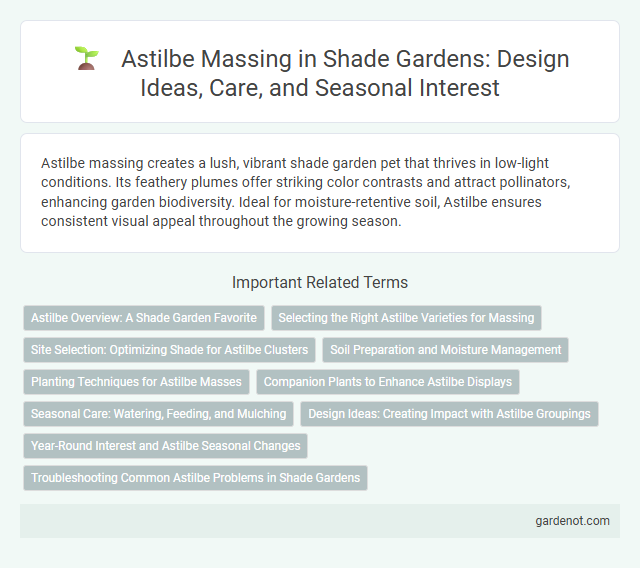Astilbe massing creates a lush, vibrant shade garden pet that thrives in low-light conditions. Its feathery plumes offer striking color contrasts and attract pollinators, enhancing garden biodiversity. Ideal for moisture-retentive soil, Astilbe ensures consistent visual appeal throughout the growing season.
Astilbe Overview: A Shade Garden Favorite
Astilbe is a shade garden favorite known for its feathery plumes and vibrant colors ranging from white to deep red. Thriving in moist, well-drained soil, Astilbe massing creates a lush, textured ground cover that brightens shaded areas with extended bloom periods from late spring to summer. Its adaptability to woodland settings and resistance to deer make it an ideal choice for dense, low-light garden designs.
Selecting the Right Astilbe Varieties for Massing
Selecting the right Astilbe varieties for massing involves choosing plants with consistent bloom times, complementary foliage colors, and uniform growth habits to create a cohesive and visually striking shade garden display. Varieties such as 'Fanal', 'Bridal Veil', and 'Deutschland' are popular for their vibrant flower plumes and reliable performance in densely planted beds. Optimal massing requires considering site conditions like soil moisture and light levels to ensure vigorous, healthy growth and prolonged blooming periods.
Site Selection: Optimizing Shade for Astilbe Clusters
Astilbe thrives in partial to full shade, making site selection crucial for successful massing in shade gardens. Choose locations with filtered sunlight or morning shade to prevent leaf scorch and promote dense, vibrant clusters. Consistent moisture and rich, well-drained soil further enhance Astilbe's lush growth and prolonged blooming periods.
Soil Preparation and Moisture Management
Astilbe massing thrives in consistently moist, well-drained soil enriched with organic matter such as compost or aged leaf mold to enhance fertility and moisture retention. Proper soil preparation involves loosening the soil to a depth of 8-12 inches to improve aeration and root penetration, ensuring the area remains cool and damp without waterlogging. Regular watering and mulching with bark or pine needles help maintain humidity and prevent soil surface drying, crucial for healthy astilbe growth in shaded gardens.
Planting Techniques for Astilbe Masses
Dense Astilbe masses thrive with evenly spaced planting, typically 12 to 18 inches apart, to ensure adequate airflow and reduce disease risk. Incorporating organic mulch around the base conserves moisture and suppresses weeds, essential for Astilbe's preference for consistently moist, well-drained soil. Grouping different Astilbe cultivars by bloom time adds continuous color, while full to partial shade locations optimize their vibrant plume-like flowers.
Companion Plants to Enhance Astilbe Displays
Astilbe massing thrives when paired with hostas, ferns, and heucheras, which complement its feathery plumes and provide contrasting foliage textures. Ferns contribute delicate, lacy greenery that enhances Astilbe's vibrant flower spikes, while hostas offer broad, lush leaves that enrich shade garden layering. Integrating heucheras introduces varied leaf colors and shapes, amplifying visual interest and supporting a balanced, dynamic shade garden environment.
Seasonal Care: Watering, Feeding, and Mulching
Astilbe massing thrives in consistently moist, well-drained soil, requiring deep watering to maintain hydration during dry spells and prevent leaf scorch. Applying a balanced, slow-release fertilizer in early spring promotes vigorous growth and abundant blooms throughout the season. Mulching with organic materials like shredded bark conserves soil moisture, regulates temperature, and suppresses weeds, ensuring optimal conditions for Astilbe's lush, dense foliage.
Design Ideas: Creating Impact with Astilbe Groupings
Astilbe massing transforms shade gardens by delivering vibrant bursts of color and texture that thrive in low-light conditions. Grouping Astilbe varieties with varying heights and bloom times creates a layered effect, enhancing visual depth and seasonal interest. Incorporate complementary shade plants like hostas and ferns to amplify the lush, dynamic appeal of Astilbe groupings while maintaining optimal moisture and soil conditions.
Year-Round Interest and Astilbe Seasonal Changes
Astilbe massing creates lush, textured layers ideal for shade gardens, offering vibrant foliage changes from deep green in spring to reddish hues in fall. Its feathery plumes bloom mid-summer, providing elevated color before fading to straw tones in autumn. This seasonal progression ensures dynamic visual appeal across all year-round interest categories, enhancing shaded landscape designs.
Troubleshooting Common Astilbe Problems in Shade Gardens
Astilbe massing in shade gardens can face common issues such as powdery mildew, leaf scorch, and poor flowering, often caused by improper watering or insufficient humidity. Regularly inspecting plants for fungal infections and ensuring consistent soil moisture while avoiding waterlogged conditions helps maintain vibrant growth. Raising air circulation and applying fungicides when necessary prevents disease spread, ensuring optimal health for dense Astilbe clusters in shaded environments.
Astilbe massing Infographic

 gardenot.com
gardenot.com